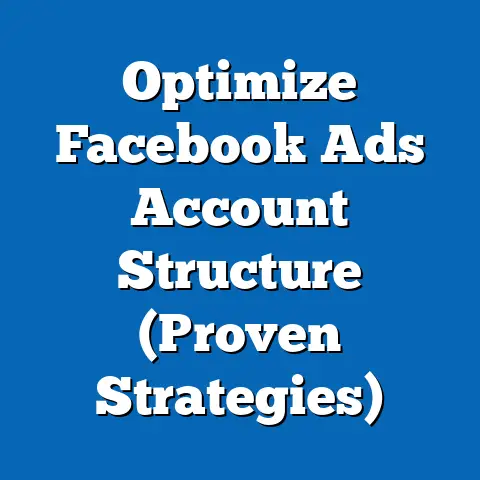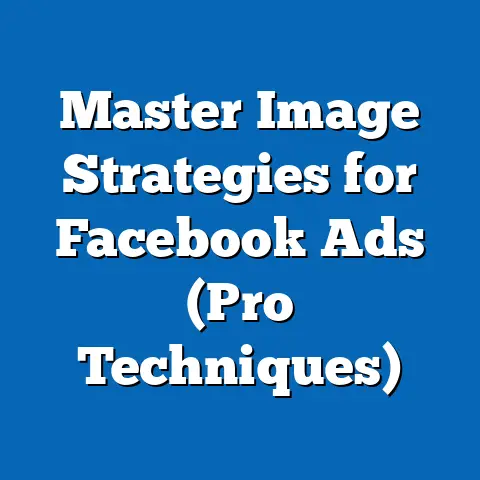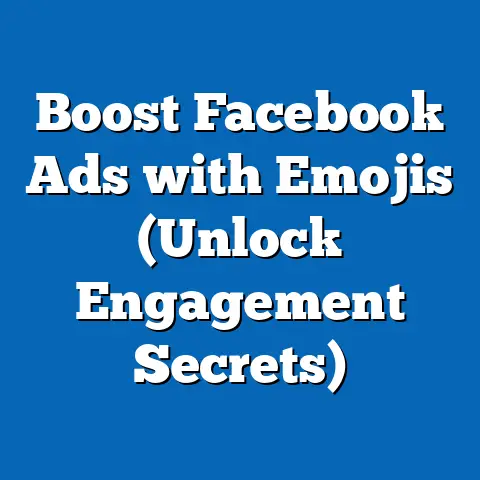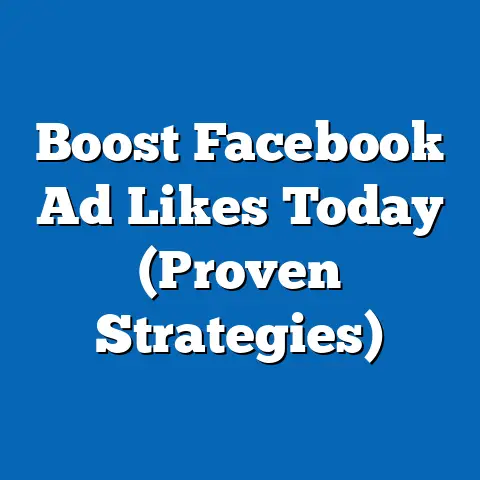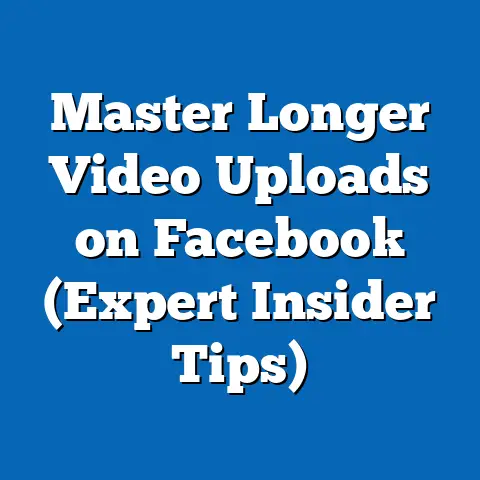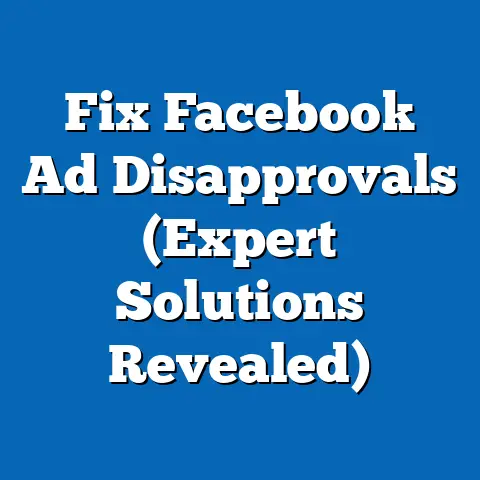Transform fb ad Strategy (Innovative Alternatives Revealed)
Facebook advertising. Just the words can conjure up a mix of emotions for marketers. Excitement for the potential reach, frustration with the ever-changing algorithms, and maybe a little bit of dread about the rising costs. I’ve been there, wrestling with Facebook Ads Manager, tweaking campaigns, and constantly trying to stay ahead of the curve. What worked last year might be obsolete today. That’s why I’m going to share some innovative alternatives to traditional Facebook ad strategies that can help you cut through the noise, reach your target audience, and ultimately, drive better results.
The Facebook advertising landscape has evolved dramatically. Remember the days when a simple boosted post could generate significant engagement? Those days are largely gone. Competition has intensified, and Facebook’s algorithm is constantly being refined, making it harder and harder to stand out. But don’t despair! This also creates an opportunity to get creative and implement novel approaches.
In this article, I’ll be diving deep into the current state of Facebook advertising, exploring the challenges advertisers face, and most importantly, unveiling a range of innovative alternatives that can help you transform your strategy. We’ll look at dynamic ads, story ads, video content, augmented reality (AR) ads, and how to leverage data, AI, community, and other marketing channels to achieve better results.
Understanding the Current Facebook Advertising Environment
Let’s start with a hard truth: the rules of the game have changed. Facebook, now Meta, is a mature advertising platform. This means increased competition, higher ad costs, and a more sophisticated user base.
Currently, Facebook boasts over 2.9 billion monthly active users, making it an undeniable powerhouse for reaching a vast audience. However, that reach comes at a price. According to Statista, the average cost-per-click (CPC) for Facebook ads in the United States can range from $0.50 to $3.00, depending on the industry and targeting options. This represents a significant increase compared to a few years ago.
One of the biggest challenges advertisers face is ad fatigue. Users are bombarded with ads daily, leading to a decline in engagement and click-through rates. It’s like the old saying goes, “familiarity breeds contempt.” The more users see the same ad, the less likely they are to pay attention to it.
Another major hurdle is navigating Facebook’s ever-changing algorithm. Facebook’s algorithm prioritizes content from friends and family, making it harder for businesses to reach their target audience organically. This means that advertisers need to be more strategic and creative in their approach.
Traditional ad strategies, such as simply boosting posts or running basic image ads, are no longer as effective as they once were. These strategies often lack personalization and fail to capture the attention of users who are constantly bombarded with content. To succeed in today’s environment, advertisers need to think outside the box and embrace innovative alternatives that can help them stand out from the crowd.
Key Takeaway: The Facebook advertising landscape is becoming increasingly competitive, and traditional ad strategies are no longer as effective as they once were. Advertisers need to embrace innovative alternatives to cut through the noise and reach their target audience.
Innovative Alternatives to Traditional Facebook Ad Strategies
Now, let’s get to the good stuff: the innovative alternatives that can help you transform your Facebook ad strategy. I’ve seen these strategies work firsthand, and I’m excited to share them with you.
Dynamic Ads: Personalized Marketing at Scale
Dynamic ads are a game-changer for e-commerce businesses. Unlike static ads, which display the same message to everyone, dynamic ads automatically showcase relevant products to individual users based on their browsing history and interests.
Imagine a customer who recently viewed a pair of shoes on your website. With dynamic ads, you can retarget that customer with an ad that features the exact shoes they were looking at, along with other similar products they might be interested in. This level of personalization dramatically increases the chances of a conversion.
The benefits of using dynamic ads are numerous:
- Increased Relevance: Dynamic ads are highly relevant to individual users, leading to higher engagement and click-through rates.
- Personalized Experience: Dynamic ads provide a personalized experience that makes users feel valued and understood.
- Automated Process: Dynamic ads are automated, saving you time and effort.
- Improved ROI: Dynamic ads can significantly improve your return on investment by driving more conversions.
I recall working with an online clothing retailer who was struggling with low conversion rates. After implementing dynamic ads, they saw a 30% increase in sales within the first month. The ability to personalize ads based on user behavior made a huge difference.
Key Takeaway: Dynamic ads are a powerful tool for e-commerce businesses that want to personalize their marketing efforts and drive more conversions.
Story Ads: Immersive Experiences That Capture Attention
Story ads have exploded in popularity in recent years, and for good reason. They offer a unique and engaging way to connect with your audience. Story ads are full-screen, immersive experiences that disappear after 24 hours, creating a sense of urgency and exclusivity.
Story ads can be used to:
- Showcase Your Brand’s Personality: Story ads allow you to showcase your brand’s personality and values in a creative and authentic way.
- Promote Limited-Time Offers: Story ads are perfect for promoting limited-time offers and creating a sense of urgency.
- Share Behind-the-Scenes Content: Story ads can be used to share behind-the-scenes content and give your audience a glimpse into your company culture.
- Drive Traffic to Your Website: Story ads can be used to drive traffic to your website by including a swipe-up link.
The key to success with story ads is to create content that is visually appealing, engaging, and relevant to your target audience. Use high-quality images and videos, and experiment with different formats, such as polls, quizzes, and interactive stickers.
I’ve found that incorporating user-generated content into story ads can be particularly effective. It adds a layer of authenticity that resonates with viewers and helps build trust.
Key Takeaway: Story ads offer a unique and engaging way to connect with your audience, showcase your brand’s personality, and drive traffic to your website.
Video Content: The King of Engagement
Video content continues to reign supreme on Facebook. Videos are highly engaging and can capture the attention of users who are scrolling through their feeds. In fact, according to a HubSpot study, 54% of consumers want to see more video content from a brand or business they support.
Innovative ways to incorporate video into your Facebook advertising strategy include:
- Live Streaming: Live streaming allows you to connect with your audience in real-time and answer their questions.
- Interactive Videos: Interactive videos allow users to engage with your content and make choices that affect the outcome.
- Short-Form Content: Short-form content, such as TikTok-style videos, is perfect for capturing the attention of users who have short attention spans.
- Behind the Scenes: Show behind-the-scenes content to build trust and authenticity.
When creating video content, it’s important to keep the following in mind:
- Grab Attention Quickly: You only have a few seconds to capture the attention of users who are scrolling through their feeds.
- Keep it Concise: Keep your videos concise and to the point.
- Use Visuals: Use visuals to enhance your message and keep viewers engaged.
- Include a Call to Action: Include a clear call to action that tells viewers what you want them to do.
I once helped a local restaurant create a series of short-form videos showcasing their most popular dishes. The videos were shared widely on Facebook and Instagram, leading to a significant increase in reservations.
Key Takeaway: Video content is highly engaging and can capture the attention of users who are scrolling through their feeds. Experiment with different formats and create content that is visually appealing, concise, and includes a clear call to action.
Augmented Reality (AR) Ads: The Future of Engagement
Augmented Reality (AR) ads are one of the most exciting and innovative developments in Facebook advertising. AR ads allow users to interact with your products in a virtual environment, creating a truly immersive and engaging experience.
With AR ads, users can:
- Try on Clothes Virtually: Users can try on clothes virtually and see how they look before making a purchase.
- Visualize Furniture in Their Home: Users can visualize furniture in their home and see how it fits with their existing decor.
- Test Out Makeup: Users can test out makeup and see how different shades look on their skin.
AR ads have the potential to transform user engagement and drive sales. They provide a unique and memorable experience that sets your brand apart from the competition.
While AR ads are still relatively new, several brands have already seen success with this innovative format. For example, Sephora launched an AR ad campaign that allowed users to virtually try on different makeup products. The campaign resulted in a significant increase in sales and brand awareness.
Key Takeaway: AR ads offer a unique and engaging way to connect with your audience and drive sales. While they are still relatively new, they have the potential to transform user engagement and set your brand apart from the competition.
Leveraging Data and AI for Targeting
In today’s data-driven world, leveraging data and AI is essential for optimizing your Facebook ad targeting. By analyzing data, you can gain valuable insights into your target audience and create more effective ad campaigns.
Data analytics can help you:
- Identify Your Target Audience: Data analytics can help you identify your target audience based on demographics, interests, and behaviors.
- Understand Their Needs: Data analytics can help you understand the needs and pain points of your target audience.
- Create Personalized Ads: Data analytics can help you create personalized ads that resonate with individual users.
AI can enhance audience segmentation and ad performance by:
- Automating the Targeting Process: AI can automate the targeting process, saving you time and effort.
- Optimizing Ad Delivery: AI can optimize ad delivery to ensure that your ads are shown to the right people at the right time.
- Improving Ad Relevance: AI can improve ad relevance by analyzing data and identifying patterns that you might miss.
One of the most effective ways to leverage data and AI is through A/B testing. A/B testing allows you to test different versions of your ads and see which ones perform best. By continuously testing and refining your ads, you can improve your results over time.
I worked with a software company that was struggling to generate leads through Facebook ads. By implementing a data-driven approach and using AI to optimize their targeting, they saw a 40% increase in lead generation within the first quarter.
Key Takeaway: Leveraging data and AI is essential for optimizing your Facebook ad targeting. By analyzing data and using AI to automate the targeting process, you can create more effective ad campaigns and improve your results.
The Power of Community and User-Generated Content
Building a community around your brand can significantly enhance the effectiveness of your Facebook ads. When you have a strong community, you can leverage their passion and enthusiasm to amplify your message and reach a wider audience.
Strategies to encourage user-generated content include:
- Running Contests: Run contests that encourage users to create and share content related to your brand.
- Asking for Reviews: Ask your customers to leave reviews on your Facebook page.
- Creating a Facebook Group: Create a Facebook group where your customers can connect with each other and share their experiences.
- Featuring User Content: Feature user-generated content in your ad campaigns to showcase the authenticity of your brand.
User-generated content can be integrated into your ad campaigns by:
- Using Customer Testimonials: Use customer testimonials in your ad copy to build trust and credibility.
- Featuring User Photos and Videos: Feature user photos and videos in your ads to showcase the real-life experiences of your customers.
- Creating a Collage of User Content: Create a collage of user content to showcase the diversity and vibrancy of your community.
I’ve seen brands successfully utilize community-driven marketing to boost engagement and sales. For example, GoPro built a massive community around their brand by encouraging users to share their adventure photos and videos. This user-generated content became a key part of their marketing strategy, driving brand awareness and sales.
Key Takeaway: Building a community around your brand can significantly enhance the effectiveness of your Facebook ads. Encourage user-generated content and integrate it into your ad campaigns to amplify your message and reach a wider audience.
Integrating Facebook Ads with Other Marketing Channels
Facebook ads should not exist in a silo. To maximize their effectiveness, they need to be integrated with your other marketing channels. An integrated marketing strategy ensures that all your marketing efforts are working together to achieve a common goal.
Facebook ads can complement:
- Email Marketing: Use Facebook ads to grow your email list and promote your email campaigns.
- SEO: Use Facebook ads to drive traffic to your website and improve your search engine rankings.
- Content Marketing: Use Facebook ads to promote your blog posts, videos, and other content.
Practical examples of cross-channel campaigns include:
- Using Facebook Ads to Promote a Webinar: Use Facebook ads to promote a webinar and drive registrations. Then, follow up with attendees via email to nurture them and convert them into leads.
- Using Facebook Ads to Drive Traffic to a Blog Post: Use Facebook ads to drive traffic to a blog post. Then, use retargeting ads to show ads to users who visited the blog post but didn’t convert.
- Using Facebook Ads to Promote a Product Launch: Use Facebook ads to promote a product launch. Then, use email marketing to follow up with users who expressed interest in the product.
I worked with a local business that was struggling to generate leads. By integrating their Facebook ads with their email marketing efforts, they saw a 50% increase in lead generation within the first month.
Key Takeaway: To maximize the effectiveness of your Facebook ads, integrate them with your other marketing channels. An integrated marketing strategy ensures that all your marketing efforts are working together to achieve a common goal.
Conclusion
The Facebook advertising landscape is constantly evolving. To succeed, you need to be adaptable and embrace innovative alternatives to traditional ad strategies.
In this article, I’ve explored a range of innovative alternatives that can help you transform your Facebook ad strategy, including dynamic ads, story ads, video content, augmented reality (AR) ads, leveraging data and AI, building a community, and integrating Facebook ads with other marketing channels.
Remember, the key to success is to experiment with different strategies and continuously evaluate their effectiveness in achieving your marketing goals. Don’t be afraid to try new things and see what works best for your business.
By embracing innovation and staying ahead of the curve, you can unlock the full potential of Facebook advertising and achieve your marketing goals. Now, go out there and transform your Facebook ad strategy!

